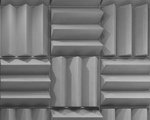So what in the world are anechoic chambers? In short, they are the consultant’s and manufacturer’s best friend when it comes to acoustics. Anechoic chambers are primarily used for a variety of acoustical measurements that determine just how much noise a product is making. These chambers are most notable for their strange appearance… their foam filled walls, ceilings, and sometimes floors of spikes look a bit like a Nerf torture chamber; if you filled them with plastic balls they’d be a hit attraction at your local Chuck E Cheese. But alas the soft spikes are not meant for harm or play but rather to absorb as much sound as possible, so that you can measure the true sound emitted or reflected off of whatever noise source you are interested in.
Anechoic chambers are meant to simulate something that we refer to as “free field”; that is a noise field that is completely free of any reflected acoustical energy. Think of it this way… If I stand in the middle of a vast field and shout at the top of my lungs whatever I say won’t come back to me as an echo; however if I stand in the middle of a gymnasium and shout the same thing I’ll hear all kinds of echoing as the sound bounces from surface to surface. These chambers allow us to measure just the initial sound and none of those echoes (we refer to the echoes as reverberant energy, but that is something for another blog). These chambers also are designed to isolate noises from outside sources to ensure that your measurements are not contaminated.
The chambers are built in a variety of sizes. One of the largest, the Benefield Anechoic Facility at Edwards Air Force Base, is capable of holding an entire aircraft. This chamber specializes in absorbing high frequency energy very far out of the range of human hearing, but the principals are much the same. Certainly this is a bit overkill if your product fits in something say the size of a shoe box, but rest assured, much smaller chambers that fit in your facility are the most common. Anechoic chambers are supplied by several very capable companies and are sometimes custom built.
At Acoustics by Design, we have the technical ability to help you specify the type of chamber that you need, and we can help ensure that it performs to a level that meets your needs. A few of the questions that we can help you answer include: Where should your chamber be located? How much outside energy does it need to block? How large should it be? What type of measurement equipment should you be using? Do you need to mitigate other outside noise sources? How do you purchase this type of equipment? Our team of experts will makes sure that your hard earned research and development dollars are well invested for your company’s future.
